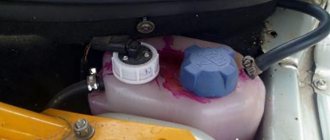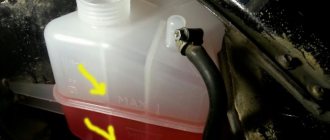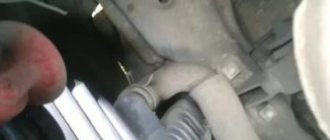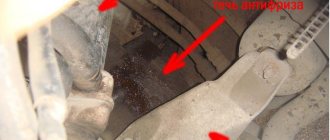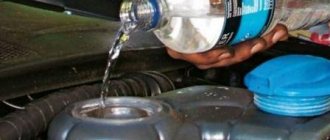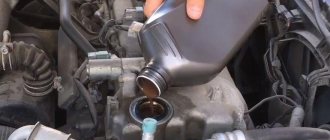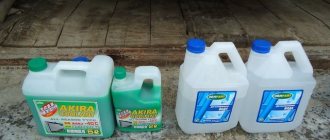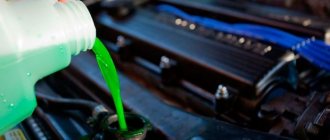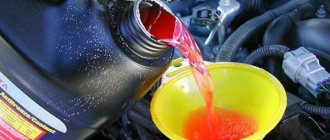Servicing a modern car is a rather complex task that includes many nuances. One of them is maintaining an optimal level of antifreeze. The efficiency of engine cooling will depend on this operation. Novice motorists often do not pay enough attention to this aspect. As a result, breakdowns may occur on the road, and the resource of the power unit is “burned out” unreasonably quickly. To prevent this from happening, you should figure out how often you need to add antifreeze to your car. But first, a little theory.
Why should you add coolant?
Antifreeze is the common name for special engine coolants. During operation, they circulate through a special circuit, which allows the generated heat to be removed. The heated antifreeze is transferred to the radiator, where it is rapidly cooled. If there is not enough process fluid or its quality is lost, then the temperature of the power unit will rapidly exceed the limit level. An overheated engine wears out quickly and may stall or even seize.
Is it possible to add water to antifreeze: common myths
The first myth. Do not mix water and antifreeze, otherwise the liquid will freeze .
Many motorists mistakenly believe that if you add water to antifreeze, it will not mix with it, but will move through the system in the form of drops or a plug. Following this logic, one can come to the conclusion that water will immediately turn into ice when the temperature outside becomes sub-zero.
In reality, everything is different. The fact is that water mixes with the refrigerant. Ethylene glycol dissolves in water, the composition becomes homogeneous. Of course, the properties of the liquid will become different, the pour point and boiling point will change. However, water will not 100% turn into ice.
We recommend
“Is it possible to mix antifreeze of different colors, and what conditions must be observed?” Read more
The second myth. You cannot add water to antifreeze, because rust will form .
The arguments are as follows: the elements inside the system are metal, they can become corroded if water gets on them. These are good reasons on which this prejudice is based. In fact, if you mix water and antifreeze, the metal inside the system will not rust. This will not happen even if you remove the antifreeze altogether and pour purified water into the system. Even after this, corrosion does not form.
Why is this happening? The fact is that the cooling system is made of non-ferrous metals, they are practically not subject to corrosion. In general, for rust to appear, oxidation must begin, and this process is impossible without the participation of oxygen. But, as you know, the cooling system is completely sealed; air does not penetrate inside it.
You should also remember that drivers poured into the cooling system before antifreeze was invented. And they poured plain water in there. Moreover, in winter, it had to be drained from the system every evening. No rust was formed, so you should not believe in this myth.
Third World. You can add boiled water to antifreeze instead of distilled water. .
Also, many advise adding water from the filter, which has settled or been treated with an ionizer. However, they do not understand what is special about water that has gone through the distillation process. This is explained simply. Distilled water contains no salts. Plain water contains salts; they are deposited in the form of scale and poorly soluble deposits inside the cooling system.
A simple filter and ionizer will not get rid of salts. It won't help even if you boil the water. The solution is the distillation process, during which water turns into steam, purified of impurities, because salts cannot evaporate. After this, the steam cools and turns into water.
When water boils, a small part of the salts settles on the walls, and you can see scale. But most of the salts do not disappear anywhere; they begin to be deposited inside the cooling system. Therefore, you should not purify water using ionizers and filters, this is also useless.
The fourth myth. You can mix antifreeze with water only on old cars .
As you already know, many years ago water was poured into the cooling system of all cars. But today almost all motorists use coolants. Therefore, some drivers are sure that if water is poured into a modern car, the cooling system will deteriorate.
In reality this is not the case. The fact is that new cars use a cooling system that is almost identical to the one that was installed on cars several decades ago. Chemical exposure with water is certainly no different. The problem is that scientists had not yet created a special coolant. In addition, when they finally began to produce it, not every car owner could afford to buy such a refrigerant. Antifreeze is inexpensive these days, and when compared to water, it has significant advantages, especially in winter.
You should not mistakenly believe that if you have a new year car, then you cannot add a little water to the cooling system. The main thing is to do it wisely and perform the procedure correctly.
Fifth myth. If you add water to antifreeze, the liquid will cool worse .
This statement is only partly true. Ethylene glycol absorbs thermal energy faster than water. When the concentration of ethylene glycol becomes low, the rate of heat removal from the motor decreases. This is true.
But how much does the cooling rate decrease? Will this negatively affect the performance of the car? Ordinary water does an excellent job of cooling, of course, more slowly than ethylene glycol, but the difference is not so significant. Therefore, water can be added to the antifreeze, engine cooling will be slightly worse, but this can only be noticed by testing in the laboratory. In addition, the cooling system is designed in such a way that it doesn't really matter how quickly the heat is removed.
Even if the heat is removed more slowly, the thermostat will begin to open slightly later, and the radiator fan will take longer to operate in a traffic jam. But the difference will be insignificant; a simple motorist will not be able to notice it. And the engine will not work any worse because of this.
Why antifreeze
It would seem, why use special fluids if water can also cool the engine? In fact, buying antifreeze is a necessity. Water evaporates quickly and can freeze, and it also activates corrosion processes and forms scale deposits. Automotive coolant is made from ethylene glycol and water. The resulting solution of dihydric alcohol does not freeze even at low temperatures and practically does not boil away when heated strongly. In addition, antifreeze contains a complex composition of corrosion inhibitors that slow down and stop oxidation processes.
You may be interested in: How often to change antifreeze when you need to replace the coolant
How to add antifreeze yourself
It is necessary to add coolant to the car engine only through the corresponding hole located on the expansion tank. What exactly needs to be done:
Remove the lid and check for the presence of liquid. If the level is at a minimum, this is a reason to be wary. At the maximum level, there is also a fear of system failure. The best option is the “golden mean”.
Typically, adding antifreeze occurs more often in winter, since the liquid is lost when the engine cools and warms up during machine downtime and idling. Do not be upset that antifreeze decreases - this is a normal process in winter. But if the liquid decreases too quickly, then you should think about checking the system or replacing the refrigerant with a more stable one. It is necessary to choose an antifreeze with a different formula that can withstand freezing and expansion.
Compound
The answer to the question of how to add antifreeze contains several points. In order for coolant to be added correctly, you need to take into account the characteristics of your car. If you decide that it is time to update the amount of refrigerant in the cooling system, you need to pay special attention to the composition. All antifreezes are divided into categories or classes:
G11.
These are traditional liquids based on ethylene glycol, water and silicate additives. They have a completely inorganic composition, so they can only be mixed with each other. For these antifreezes, manufacturers usually choose colors such as blue, green and sometimes yellow.
G12.
These are coolants that are called organic or carboxylate. Their base is also ethylene glycol, but compositions with carboxylic acid are used as additives. Such substances can be combined with the same or with antifreezes, the labeling of which contains advantages. Most often, such liquids are painted in warm colors: red, purple, pink and orange.
G12 (with pluses).
These are hybrid compositions that contain both silicate additives and organic additives based on carboxylic acid. They are suitable for mixing with other liquids from this category or with refrigerants of the G12 category. By color you can most often find bright yellow, lilac, purple and scarlet antifreezes of this class.
G13.
These substances are known as lobrids because they are significantly different from other refrigerants. The composition of coolant belonging to this category is based on propylene glycol. Therefore, such compositions can only be mixed with each other. They are painted in lilac, pink and purple colors, but sometimes you can also find yellow G13 class antifreeze.
MULTIFREEZE.
This liquid is a unique product that can be mixed with representatives of any class. Its composition is compatible with both traditional inorganic and carboxylate antifreezes. Multifreeze is also suitable for adding to hybrid and lobride liquids.
Is it possible to add incompatible compounds to the cooling system? No, this will damage the car. If you do not know what kind of antifreeze was poured into the car at the factory, it is better to drain the remaining amount. This must be done so that the new product does not enter into an unpredictable chemical reaction with it.
How not to make a mistake with your choice
To select coolant for your car more consciously, you need to have an idea of the classes of this type of product. The market today offers antifreeze in one of the following categories:
- 1. G-11. These fluids are made using HOAT technology and belong to the hybrid group.
- 2. G-12 and G-12+. This is how carboxylate compounds are labeled, for the production of which OAT technology is used.
- 3. G12++ and G13. The most modern and technologically advanced antifreezes from the lobrid group.
Mixing compositions of different classes is generally not recommended. There are exceptions to this rule: G12+ antifreeze can be added to G12 and G11. You cannot add domestic antifreeze to modern coolants, because they are too different in composition. If the coolant level has decreased by more than a third, then most likely a complete replacement will be required.
Frequency
How often do you add antifreeze and is it necessary to do so? It is impossible to give a definite answer to this question. It all depends on the following variable factors:
- type of coolant;
- refrigerant composition;
- additive compositions;
- car brand;
- features of vehicle operation.
it is important! Today, the market offers coolants made on the basis of silicate and carbosilicate. Original silicate antifreeze from a good manufacturer retains its quality for 3 years or 150 thousand km. Carbosilicate liquids can last up to 5 years or 250 thousand km. When deciding to add antifreeze to your car, you must first read the recommendations of the car manufacturer.
Features of the brand.
Some manufacturers, such as Volkswagen, Mazda and GM, claim that adding coolant is not required at all. Throughout its entire service life, the car will run on factory antifreeze. But in reality, it all depends on the operating conditions of the car and its mileage. Therefore, we recommend checking the antifreeze level at least every 5 years.
Consequences of low or no antifreeze levels
An excessive amount of antifreeze leads to its leakage.
The antifreeze level in the expansion tank should be between two drawn lines indicating its minimum and maximum value. If the level is low, but the refrigerant is still present in the tank, then nothing bad will happen, since there is sufficient antifreeze in the radiator and cooling system.
The lack of antifreeze in the expansion tank can lead to serious overheating of the engine. Firstly, it is quite easy to air out the entire coolant circuit. This will immediately lead to local overheating of the power plant, most likely the coolant will boil, but this is only the most positive scenario. Most often, a complete lack of coolant leads to serious problems: the engine can easily seize due to severe overheating, the piston pins will stick to the pistons, and the compression and oil scraper rings will simply stop springing and become lodged in the piston. Secondly, the cylinder head gasket and the head plane will receive a portion of damage, after which the sealing element will have to be replaced, and the cylinder head will need to be milled. In the case of engines with an aluminum block, the damage will be much more serious.
Low antifreeze level
Step-by-step instruction
If you are going to add antifreeze for the first time, you probably have questions:
- to what level should it be added;
- where to fill the fluid, into the tank or radiator.
We have prepared step-by-step instructions with which you can independently add refrigerant to your car when it is cold:
1 step.
First you need to install the car correctly. For convenience, it is better to place it on a slope so that the hood is higher than the trunk. This will allow air pockets, if they have formed, to escape from the cooling system pipes. If you need to add just a little liquid, you can leave the machine in a horizontal position.
Step 2.
Carefully open the expansion tank cap. In case there is high pressure in the system, cover it with a rag. For added protection, wear gloves to prevent injury to your hands.
Step 3.
Smoothly and slowly pour antifreeze into the hole. This should be done in a thin stream and gradually. Its level should reach approximately 2/3 of the expansion tank.
Step 4
Start the engine and keep it running for about 5 minutes. This will allow the coolant to distribute throughout the system. If after this the amount of refrigerant in the tank has decreased, you can add a little more.
Step 5
Close the lid, wipe it, the neck and surfaces that have been splashed with antifreeze.
What you need to know to avoid mistakes
Correctly mix liquids of the same class. The exception is adding G12+ antifreeze, which can be added to G11 and G12. If you do not adhere to this rule, an insoluble sediment may form, which will gradually clog the pipes and cause premature engine wear.
It is strictly forbidden to pour antifreeze into antifreeze, because they differ greatly in chemical composition.
The coolant is produced both in the form of a mixture, which can be poured immediately, without preliminary preparation, and in the form of a concentrate.
It is forbidden to take concentrated products for refilling, even if the classes of antifreeze are the same: first, the concentrate is diluted according to the instructions. Proportions are often determined by the planned operating temperature conditions.
How does operation affect
Abnormal engine operating conditions are a powerful factor in reducing the quality of the coolant. They may require topping up or completely replacing antifreeze. Typical negative factors include the following situations:
- prolonged operation of an overloaded vehicle;
- driving with low refrigerant levels;
- emergency topping up of unsuitable antifreeze;
- water entering the cooling system.
Consequently, the operating conditions of the vehicle also greatly influence how often antifreeze needs to be added.
Why do you need antifreeze
Various types of antifreeze are available. Their properties also differ. All such liquids have in common that their boiling point is high and their freezing point is low.
The main purpose of antifreeze is to cool the car engine and equalize the temperature of its individual sections
Another function of coolant is to reduce the load on individual engine parts. It also prevents the spread of corrosion. These properties are determined by special additives and additives. The liquid is involved in heating the passenger compartment and the throttle body, because the stove is part of the cooling system.
If the volume of antifreeze is insufficient, the engine overheats, which can lead to a decrease in thermal clearances, accelerated wear, and possible jamming of connecting rod and piston parts. The result is a broken connecting rod and a major overhaul or replacement of the engine.
Typical mistakes when adding coolant
It is necessary to replenish the refrigerant level in the system not only on time, but also correctly. In their manuals, car manufacturers describe in detail all the details of the procedure. There are always recommendations on the packaging of any antifreeze. But to many motorists the process itself seems simple, so no one delves into the technical documentation. So that you can avoid common mistakes, we have prepared a rating of them.
1. Constant rush
Automotive and coolant manufacturers emphasize in bold letters, warnings, and exclamation marks the strict need to add antifreeze to a “cold” system. At a minimum, the car should stand with the engine turned off for at least 10 minutes. What are the consequences of a violation? First of all, it is dangerous.
it is important! When adding cold liquid to hot liquid, a characteristic bubbling begins. As a result, the hasty motorist gets burns on his hands and greasy stains in the engine compartment. But there is also a technical aspect. The heated liquid occupies the maximum volume, so you will only need to add a little. As it cools, the antifreeze level will drop, but you won’t notice it.
2. Adding water
The chemical composition of automotive coolant is calculated based on the standard water content - approximately 5%. At this concentration, all anti-corrosion, anti-foam and other performance properties of the product are preserved. If you simply add water, then it is no longer possible to guarantee any properties of the entire liquid. Such actions often lead to freezing, which ultimately damages the line and radiator. Adding water is allowed only in emergency situations, when you need to raise the coolant level, but there is nowhere to get a suitable composition. Immediately after an abnormal dilution of antifreeze, you need to go to a service station to flush the system and fill it with good refrigerant.
3. Sudden movements
This error is also related to security issues. It lies in the fact that some motorists sharply unscrew the filler cap. If the machine has recently been operated, such actions may result in the release of a large volume of hot steam. To protect yourself from burns, you need to act carefully and slowly.
4. The details were mixed up
Some motorists, especially those who have never encountered the problem of adding antifreeze, want to add it directly to the radiator. This can only be done with some car models; for others it is better to use an expansion tank. If the radiator design of your car is collapsible, you can add coolant there. But this will make it more difficult to determine its level in the system and prevent the occurrence of air locks.
5. More is not better
There is no need to confuse antifreeze and engine oil. If the latter needs to be filled to the limit, then it is better to stop the coolant level in the middle of the expansion tank. If there is an excess of liquid, its thermal expansion will lead to increased pressure in the system. At best, this will result in a cracked tank, but you may also encounter ruptures in the system.
6. Matching by color
Adding antifreeze according to rules like “red to red” or “blue to blue” is a gross mistake. In fact, no one regulates the color schemes of manufacturers. The choice of coolant should be based on its chemical composition.
Is it possible to add antifreeze?
Is it possible to add another antifreeze? This is prohibited if the properties of the refrigerants are different. Otherwise, a solid precipitate will form after mixing incompatible liquids. As a result, coking of the radiator channels and other system elements will occur. To prevent this from happening, you can add coolant to the car that is recommended by the automaker for your car model. The composition of such a refrigerant will be identical to the composition of what has already been filled.
As for whether it is possible to add distilled water to antifreeze, there is no exact answer to this question. If the percentage of added liquid is small, the refrigerant will retain its original properties unchanged. However, you should not add untreated tap water to antifreeze.
Many inexperienced drivers do not know whether it is possible to add antifreeze of a different color. Here it is worth paying attention to the fact that the shade of the refrigerant does not affect its composition. For example, it may turn out that it is allowed to add blue antifreeze to red one.
Is it possible to add antifreeze of the same color, for example, to a green refrigerant the same green antifreeze, but with different properties? You can't do this. The fact is that the composition of such liquids will differ, as well as the additives added.
Most car owners have no idea where exactly they need to pour antifreeze. By mistake they pour it into the radiator socket. This hole is present in this mechanism, but only if the model is collapsible. When the body of the radiator system is solid, adding antifreeze is prohibited directly. The coolant is poured into the radiator, as well as into all parts of the cooling system through the expansion tank.
When you plan to completely remove used coolant, for example, when you replace antifreeze with another brand of antifreeze, you need to drain it from a collapsible radiator through an individual hole. It may also be necessary to remove the protective panel on the bottom to get to the additional plug through which the remaining fluid will flow out.
We recommend
“What kind of antifreeze to pour into a Peugeot: color, brands, manufacturers” More details
It is not necessary to follow the standard instructions for changing antifreeze in all cases. After all, many cars are equipped with such cooling systems, the antifreeze from which must be drained in a special way. Most often, cars made in England have an individual drain scheme. If you can replace antifreeze in your car using a simplified system, even a beginner can handle this job, because no special knowledge or tools are required.

